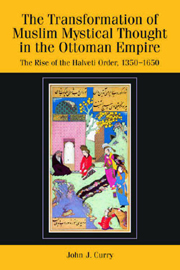 The Transformation of Muslim Mystical Thought in the Ottoman Empire
The Transformation of Muslim Mystical Thought in the Ottoman Empire Book contents
- Frontmatter
- Contents
- List of Maps and Figures
- Abbreviations for Frequently Cited Works in the Text
- Acknowledgments
- Note on Transliteration
- Map 1
- Map 2
- INTRODUCTION: ON THE STUDY OF OTTOMAN MYSTICAL TRADITIONS
- PART I THE RISE AND SPREAD OF THE HALVETİ ORDER FROM ITS ORIGINS THROUGH THE ELEVENTH/SEVENTEENTH CENTURY
- PART II THE EVOLUTION OF A HALVETİ SUB-BRANCH: THE LIFE AND CAREER OF ŞAcBÂN-I VELİ AND HIS FOLLOWERS IN THE KASTAMONU REGION
- INTRODUCTION
- 3 ECHOES OF A DISTANT PAST: ŞAcBÂN-I VELİ'S EARLY LIFE AND CONVERSION TO SUFISM
- 4 GENESIS OF A SUB-BRANCH: ŞAcBÂN-I VELİ'S STRUGGLES IN KASTAMONU
- 5 AN UNEVEN LEGACY: THE SUCCESSION TO ŞAcBÂN-I VELİ TO THE END OF THE TENTH/SIXTEENTH CENTURY
- PART III DEFENDING THE CULT OF SAINTS IN ELEVENTH/SEVENTEENTH-CENTURY KASTAMONU: TRANSFORMING THE ŞAcBÂNİYE ORDER UNDER cÖMER EL-FUɔÂDÎ
- CONCLUSION: WHAT CAN THE ŞAcBÂNİYE TEACH US ABOUT TRANSITIONS IN THE EARLY MODERN PERIOD OF WORLD HISTORY?
- Appendix I
- Appendix II
- Works Cited and Further Reading
- Index of Persons
- Index of Places
- Index of Subjects
3 - ECHOES OF A DISTANT PAST: ŞAcBÂN-I VELİ'S EARLY LIFE AND CONVERSION TO SUFISM
from PART II - THE EVOLUTION OF A HALVETİ SUB-BRANCH: THE LIFE AND CAREER OF ŞAcBÂN-I VELİ AND HIS FOLLOWERS IN THE KASTAMONU REGION
Published online by Cambridge University Press: 12 September 2012
- Frontmatter
- Contents
- List of Maps and Figures
- Abbreviations for Frequently Cited Works in the Text
- Acknowledgments
- Note on Transliteration
- Map 1
- Map 2
- INTRODUCTION: ON THE STUDY OF OTTOMAN MYSTICAL TRADITIONS
- PART I THE RISE AND SPREAD OF THE HALVETİ ORDER FROM ITS ORIGINS THROUGH THE ELEVENTH/SEVENTEENTH CENTURY
- PART II THE EVOLUTION OF A HALVETİ SUB-BRANCH: THE LIFE AND CAREER OF ŞAcBÂN-I VELİ AND HIS FOLLOWERS IN THE KASTAMONU REGION
- INTRODUCTION
- 3 ECHOES OF A DISTANT PAST: ŞAcBÂN-I VELİ'S EARLY LIFE AND CONVERSION TO SUFISM
- 4 GENESIS OF A SUB-BRANCH: ŞAcBÂN-I VELİ'S STRUGGLES IN KASTAMONU
- 5 AN UNEVEN LEGACY: THE SUCCESSION TO ŞAcBÂN-I VELİ TO THE END OF THE TENTH/SIXTEENTH CENTURY
- PART III DEFENDING THE CULT OF SAINTS IN ELEVENTH/SEVENTEENTH-CENTURY KASTAMONU: TRANSFORMING THE ŞAcBÂNİYE ORDER UNDER cÖMER EL-FUɔÂDÎ
- CONCLUSION: WHAT CAN THE ŞAcBÂNİYE TEACH US ABOUT TRANSITIONS IN THE EARLY MODERN PERIOD OF WORLD HISTORY?
- Appendix I
- Appendix II
- Works Cited and Further Reading
- Index of Persons
- Index of Places
- Index of Subjects
Summary
While some Muslim saints were born into prominent family lineages and attracted historical attention from their earliest years, Şacbân-ı Veli was not among this group and only rose to prominence in a later era. Therefore, the picture we receive of his early life and his eventual incorporation into the following of the Halveti order is among the most ill-documented parts of his life. Nevertheless, these events are not without value for the historian if they are placed within the political, religious, and social context of early tenth/sixteenth-century Asia Minor under a recently ascendant Ottoman state.
ANTECEDENTS OF ISLAMIC AND SUFI CULTURE IN KASTAMONU BEFORE THE ARRIVAL OF ŞAcBÂN-I VELİ
By the time Şacbân-ı Veli made his home in Kastamonu in the first half of the tenth/sixteenth century, the city had already been integrated into the Islamic world for several centuries. After the invasions of the Seljuks, various Turcoman tribes, and Latin Crusaders following the defeat of the Byzantines by the Seljuk ruler Alp Arslan at Manzikert in 463/1071, a Turcoman dynasty known as the Danishmendids established themselves in north-central Anatolia. They appear to have first taken control of Kastamonu in 498/1105. Although the city passed briefly back into Byzantine hands periodically over the subsequent three decades in conjunction with campaigns of various Byzantine rulers and generals into the Anatolian plateau, a nominally Muslim sovereign ruled over the city until the Ottoman absorption of the province following the conquest of Constantinople in 857/1453.
- Type
- Chapter
- Information
- The Transformation of Muslim Mystical Thought in the Ottoman EmpireThe Rise of the Halveti Order, 1350–1650, pp. 93 - 107Publisher: Edinburgh University PressPrint publication year: 2010


